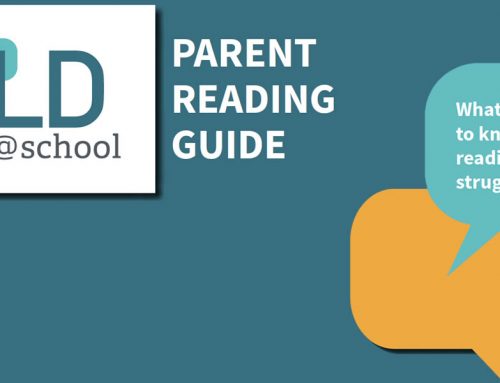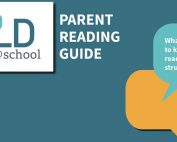Written by Farzad Mirza, OCT, Ottawa-Carleton District School Board
As a parent who is now finding themselves charged with being their child’s teacher, it can be challenging to have to teach math concepts you may not have touched for many years; especially if your child has a learning disability (LD). My hope is that this article will show you five helpful ways you can help to engage and support your child with math at home.
“New” Math and Math Anxiety
Teaching intermediate students, I find I am frequently asked one key question by parents during our initial meetings: What is NEW math? Let me start by saying that I can assure you they have not invented new math concepts for quite some time (speaking strictly at the elementary level. Math – like most sciences – does change and grow). So what is new about this math? It is simply a new way of looking at old concepts. Rather than drilling one concept through rote, we display a few options to students. New math expands mental math techniques and strategies.
Take, for example, 72 – 17. Most of us from the older system of education would use a standard algorithm in our minds to solve this problem (work on the 1s column, then the 10s column):
72
– 17
——–
55
New math teaches various mental techniques such as “adding up”:
I know that 17 + 50 = 67
67 + 3 = 70
70 + 2 = 72, so
50 + 3 + 2 = 55
or “adjustment”:
I don’t like numbers that aren’t rounded, so instead of 17 I’ll adjust it to 20.
72 – 20 = 52. Since I added 3 to 17, I need to add 3 to my answer.
52 + 3 = 55
Students with learning disabilities in math often have low self-esteem and feel anxiety around math, so approaching with confidence and positivity can help encourage your child to make attempts at problems they may find difficult. For students with LDs, it can be quite helpful to have so many different ways to approach problems, as they can find what works best for them. Maybe you will find something that works best for you as well!
Focus on the Basics
Don’t understand Pythagorean Theorem? Forgot how to balance an algebraic equation? Try your best not to worry about that. One of the biggest challenges teachers at the intermediate level and above face is that quite a few students still struggle with the basics of addition, subtraction, multiplication, and division. It is not necessarily that students cannot solve these problems, but that they struggle with the length of time it takes them to do so. For students with LDs or those who simply aren’t confident in their number facts yet, know that it is okay to take some time to practice these basic skills. You don’t have to enforce that they memorize their multiplication tables, but rather allow them physical resources that they can use. For example, small pocket charts like a number chart, or a multiplication rule table that your child can keep referencing (I would avoid an over-reliance on a calculator, as this will strengthen estimation abilities in the long run). As they keep practicing their tables, they can scratch off the facts they’ve mastered. Having their tables in front of them, and encouraging your child to use them, will promote understanding of number facts.
Click here to download free math charts, from the website Teachers Pay Teachers.
So keep it simple, and focus on the basics. There is nothing wrong with running through these vital operations over and over again in various ways (games, challenges, etc). It does not have to be on a worksheet; you can post questions daily on your fridge that your child can answer as they go to grab a snack or a drink, etc.
Click here to read the article Solving Math Problems with Heuristics at Home.
Math isn’t Just for Classrooms
Incorporate math into your daily activities with your kids. Some examples: for primary students, make them count how many grapes you’ve given them in a bowl, then have them eat a certain amount to find out the difference. Ask your intermediate student to tally up the grocery receipt and ask how much money you spent after taxes. If you are working on a home improvement project, have your child help with the measurements and calculations. The higher up in grade you go, the more complex abstract concepts you will find. Finding ways to make these concepts concrete (something your child can see or manipulate), helps your child see their application in everyday use. For your more mature students, you could create a whole unit around plotting and calculating the percentages and percentage increases of the virus spread (not to strike fear, but to teach the importance of paying attention to statistics). You don’t need to just have your child sit down at a desk with worksheets and textbooks for them to learn. The math curriculum across all grades includes a specific expectation of utilizing concepts in real-world scenarios, so take full advantage of every opportunity that presents itself (you may enjoy the lesson too)!
A few more activities:
Primary
More or less: fill a jar with a different object each week (coins, Lego, candies) and ask your child to tell you how many they think are in the jar, as well as if it is more or less than the previous week.
Sorting: have your child sort toys (Lego and Duplo work well!) or even laundry into different categories. Ask to explain how they decided on groups and how many are in each group.
Intermediate
Measure the area and volume of surfaces and objects around the house. They could even help you with a household project!
Build a city out of geometric shapes and concepts. Click here to find a free, printable template for this activity.
For an example activity using manipulatives, click here to read the article Counting to 99.
Click here to read the article Using Manipulatives to Support Math Learning at Home.
Talk in Math
Math is a language. Much like any other language, strengthening it revolves around conversation. Talking about math can help children understand discussion, explanation, and reasoning. It revolves around questions such as “Why do you think this?”, or “How could we solve this problem?” These types of conversations can help strengthen students’ reasoning and logic skills. Math Talks (also called Number Talks) are a way for students to focus on a solution to a chosen problem and discuss the reasonableness of that answer. In short: Math talks are about different strategies and reasoning, number talks are about solutions, and whether it is reasonable or not. The beauty of these is that they can pop-up organically and BOTH are great ways to enhance mathematical learning, especially by helping you see how your child decodes, solves, and justifies a problem. An example of a talk for proper estimation: “How many peanuts are in this jar? What strategy could we use to get a reasonable answer?”
Math Talks can also show why a child has made errors in their math. Most students try to avoid making mistakes at any cost; this is equally true of students with LDs in mathematics. As soon as they make a mistake, they quickly erase it and write down the correct answer. All too often, however, they do not take the time to understand why their answer was different. And sometimes their answer is correct—just different! Parents can use the mistakes their children make by using them to shed light on misconceptions and areas of weakness.
Click here to read the article Are Number Talks an Effective Strategy for Students with LDs?
Example starters for Number Talks:
- Target Number: Ask your child to reach a target number using other numbers provided:
Example: The target is 10, how can we get there with the numbers 2, 3, 4, 5, 7, 8, 12 and 15? - Represent It: Give your child a number and ask how many different ways they can represent it.
Example: 12 can be represented as 10+2, (5×2)+2, 6×2, etc. - Equal To: Give your child an equation and ask your child to come up with an equation that would give the same answer.
Example: 5+2 would give the same answer as 3+4, 6+1, 10-3, etc.
As I said, it is a language – so don’t expect your child to be fluent right away. Build up your child’s vocabulary by pre-teaching keywords, and use those words daily yourself. My students were so used to me constantly asking “Did you double-check your solution? Does this look reasonable to you?” that they now ask each other before I get the chance to. Slowly build your child’s vocabulary with a math ‘dictionary’ – lists of the keywords they are learning that they can reference. Again, this can be pocket-sized, or larger. If I were to translate from English to French, I may need my dictionary and grammar reference book, due to my lack of knowledge of the language. It’s only fair that a student struggling with math should be allowed the same! You can help your child by providing a glossary of terms to refer to (click here to view the free math vocabulary lists available on Teachers Pay Teachers), or you can even work together to create your own!
Take a Step Back
I work daily with students at different stages in their math learning. Despite teaching intermediate students, the reality is I have students who are academically across the board from grade 4 levels, up to those who can challenge grade 9 concepts. The math continuum guides us to see a student’s current skill level, and where they should be in their development. For example, does the student still count with their fingers, skip count, or use automatic retrieval? To help students progress, we must slowly build the skills of those who are behind on the continuum.
As parents, however, we can find ourselves striving to make our children learn and understand math at the same rate as their peers. The truth of the matter is, some concepts and strategies – while easy for you – are hard for our kids to understand, especially if they have an LD. Try to take a step back from where your child should be and reteach from where they actually are! Children will LDs will often need to go back to previous concepts to make steps towards new ones. Take it slow, and be proud of what they do accomplish (the big, and the small).
Also, do not focus solely on whether the answer is correct or not. Having a correct answer is only part of my grading, along with processing and reasoning. An incorrect answer is a great way to challenge your child’s reasoning and problem-solving. See if they can spot the error. If it is a calculative error, that doesn’t mean they didn’t understand the concept. If it was conceptual, then it is a good chance for them to rethink their step-by-step strategies.
Technology is your Friend
Take full advantage of resources online. For children grade 6 and under, there are many interactive sites, such as Prodigy, Math Playground, or StudyLadder (which can be used for many subjects). For the older generation, there are sites such as CK-12 and Khan Academy. For any grade, there are many websites that generate worksheets (Google search “Math worksheets” and you’ll see what I mean – some sites are free, some with a membership), as well as many sites and Youtube videos to help teach a concept (note the keyword “help”). Even KenKen or Sudoku puzzles found online can help with number skills. Don’t be afraid to use technology to help you teach.
Final Words
Math is fun and exciting (at least to me)! Try to keep it that way for you and your child. If you are not enjoying it, it will be hard for your child to enjoy it, too. Keep things light, and please keep it all in perspective. The uncertainty of the next few weeks and months will take its toll on everyone. It’s a good idea to stop, smell the roses, count how many petals the roses have, calculate the surface area of the petals, graph… okay, maybe just stop and smell them with your children.










